‘I Wanna Dance with Somebody’ has recently been nominated by the Visual Effects Society for Outstanding Supporting Visual Effects – the very first VES Award nomination for our talented ReDefine team!
Can you start by introducing yourself?
Hi, I’m Andrew, Visual Effects Supervisor at ReDefine. I’ve been here for three years or just over.
What was it like to work with Kasi Lemmons on such a high-profile project?
We worked closely with Kasi and Paul Norris, the overall VFX supervisor. Like all filmmakers, she wanted the best visual effects for her film, hence, we delivered!. Kasi gave us very clear direction and shared lots of valuable feedback on a regular basis.
Tell us more about the collaboration with Dimension Studios.
The team provided all the pre-planned assets for the show, including over 500 textured and categorized movements. The assets were easy to integrate into our pipeline and met our needs. Though the large amount of data generated could have become a problem, it was planned for and contained to a manageable size.
How many ReDefine sites worked on the show and what was the collaboration across the global sites like?
The collaboration between myself (based in London) and our counterparts in Montreal, Mumbai, and Pune was seamless and highly productive. As the liaison between the teams, I played a key role in ensuring smooth communication and coordination. Montreal was responsible for establishing the pipeline, while the Indian team tackled the shot work. By holding regular cross-site meetings, we were able to stay on the same page and quickly adapt to any unexpected scenarios. Despite the tight timeline of just 12-13 weeks from start to finish, we were able to meet all deadlines by closely monitoring progress and utilizing parallel departmental efforts.
What does it require from a VFX Supervisor to make sure all the work is functioning in a very smooth way apart from planning? In terms of giving insight to our audience, is there any advice you’d like to give to them on handling two different sites, two different time zones in a very short time?
Effective communication and clear delegation of tasks are crucial for successful collaboration. We established early on that Montreal would lead the initial approach for the crowd shots. By clearly communicating this to the India team, we avoided any confusion or duplication of effort. Proactivity also played a key role in our success. Before we even began, I proactively reached out to various CG and Crowd supervisors to gather their expertise and insights on the best approach for handling the work within our pipeline. This allowed me to make informed decisions for the studio and ensure that we utilized the best ideas from all team members. By keeping everyone on the same page, we were able to work efficiently and achieve our goals.
What was the process to create the crowd shots?
Creating a montage sequence requires careful planning and attention to detail. For our project, the client provided specific requirements for the stadiums they wanted to feature, including the tour and the number of indoor and outdoor arenas. To ensure that the locations were visually distinct and met the client’s needs, we conducted thorough research on all the stadiums the artist had performed at, carefully selecting those that met the criteria and provided visually diverse backgrounds. We also leveraged the natural darkness of nighttime and relied heavily on lighting within the stadium such as spotlights and stage lighting to enhance the visual appeal of the crowd. By doing so, we were able to create a dynamic and engaging montage sequence without the need for overly detailed stadium models. Additionally, our pipeline and DMP techniques allowed us to work efficiently and effectively, incorporating existing tools for the crowd shots.
Creating realistic crowd shots required careful attention to detail. We balanced the number of people clapping, standing and cheering to create a believable concert crowd. We established a generic crowd setup and adjusted it to match the unique requirements of each shot. By starting with a generic crowd and slowly tailoring it, we were able to work efficiently and effectively while maintaining realism.
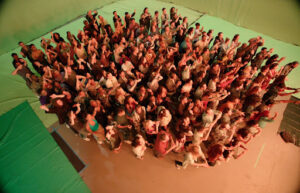
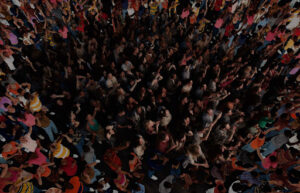
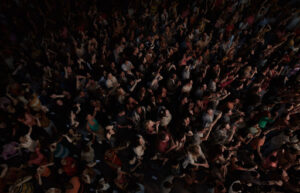
We collaborated across departments to create realistic lighting effects. The Animation team handled spotlights, passing the work to Lighting to make it look realistic, and then on to the final compositing stages. By utilizing the expertise of each department and avoiding relying too heavily on one, we were able to efficiently create high-quality results and meet deadlines.
So considering there was a medley of 2 main songs and 4 different locations, how did you guys manage to make sure that the crowd was in sync with that music? How did it all turn out to be a complete package for that whole sequence?
In ‘Bohemian Rhapsody’ the approach we took for crowd shots was slightly different from “I Wanna Dance with Somebody.” Since the crowd was specifically shot for a song, we had to be selective about which crowd caches we used and when to align with the music. We also had to change some crowd actors to fit the music, and align the clapping people with the specific beats. To create a realistic look, we also let some claps slip a bit as there is always a bit of slip with the audience tapping and performing. Even though it was a specific song, we thought we could work with these generic elements and adjust them as needed.
You were a Comp Supervisor on ‘Bohemian Rhapsody’. How different was it to recreate the stadiums for ‘I Wanna Dance with Somebody’?
On ‘Bohemian Rhapsody’ the main sequence was at Wembley, where we recreated Live Aid scenes and had extras perform the dance moves in time with the song, while on ‘I Wanna Dance with Somebody’ we broke it down into different scenes and made a library of generic elements to choose from. Having worked on ‘Bohemian Rhapsody’ for the same client, I had a head start in understanding their expectations and was able to apply that knowledge to ‘I Wanna Dance with Somebody’.
What were the biggest creative and technical challenges you faced during production?
Creating realistic crowd shots was a challenge of finding the right balance of performance and appearance, and strategically placing the limited number of assets to avoid repetition. I think we must have turned 500 people into 40,000 or so. The most difficult aspect of the project was the tight timeline and the need for experienced, senior staff to work efficiently and effectively. To increase the number of assets, we used tools to change costume colors and brightness to create variations. The project was completed within a 14-week timeframe.
What tools and techniques did you use for the process of crowd scattering? Could you, in a very short manner, explain to our audience how the crowd scattering works and what are the technologies, the tools behind that?
In order to create realistic crowd scenes for “I Wanna Dance with Somebody,” our team utilized Houdini to scatter 40,000 points, each representing an individual asset, across a stadium surface. This allowed for easy editing of specific assets within the crowd. We also employed the use of Clarisse to handle the high density and polygon count of the crowd, allowing for quick iteration and rendering during the lighting stage of the pipeline. By streamlining our pipeline and utilizing these tools, we were able to efficiently produce high-quality visual effects and constantly improve the performance of the crowd scenes.
Is there any particular moment on the show that you remember as “special”? Or do you have a favourite shot you worked on?
I suppose my favourite shots are ones that actually came by accident. For one of them, the client told us it was a low priority (back-up) shot. The second one was just a normal shot – a plate that had to be matched to everything else. What ended up happening though was that this backup shot became one of the best shots in the film. It sparked so much creativity amongst the whole team.
The shot of the crowd looking up at the jumbotron was a standout moment in the project. The use of a foreground crowd layer made it difficult to tell that it was a fully computer-generated shot. Despite initial challenges with layout and changes requested by the client, we were able to quickly pivot and create a unique and impactful shot. By positioning the crowd at the front stage and using the darkness to highlight the shape of the stadium, we were able to produce a visually interesting and dynamic shot in a short amount of time.
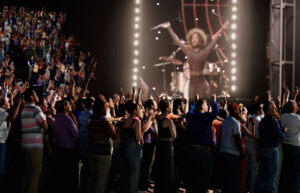
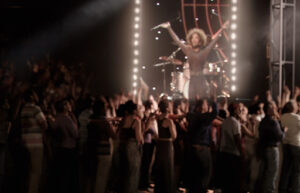
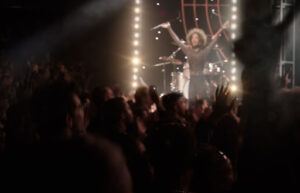
Is there a message you’d like to share with your crew?
Thank you to my crew! There’s no one person in visual effects who’s like the lynchpin to make it all work. I know VFX Supervisors get a lot of credit, but actually you’re only as good as your team is. So no matter how good that supervisor is, they can only do so much. If you don’t have the team to back you up, there is no excellent final product. My team did a fantastic job. Everyone delivered above and beyond and that attitude produced great results. My key message is always ‘Thank you’ and I say it on every call because I know how much hard work goes into projects like these.
What are you up to next? What are your other projects?
I just finished up a Netflix show – more on this one soon! We also have another TV show in production that is wrapping up in the near future. A lot of projects are being worked on simultaneously these days – and they keep me busy.
To round up this interview, we’re now very curious, what is your favourite Whitney Houston song?
The Bodyguard soundtrack is sure to be a hit. The iconic song ‘I Will Always Love You’ is a timeless classic and a standout in the film. Similar to my experience working on ‘Bohemian Rhapsody’, I’ve gained a newfound appreciation for the music featured in the film. Though it may not have been at the forefront of my personal taste prior to working on the project, through repeated exposure and learning more about the music, I’ve become a fan of both Whitney Houston and Queen. It’s truly a great experience to see how working on a film can shape one’s musical preferences.